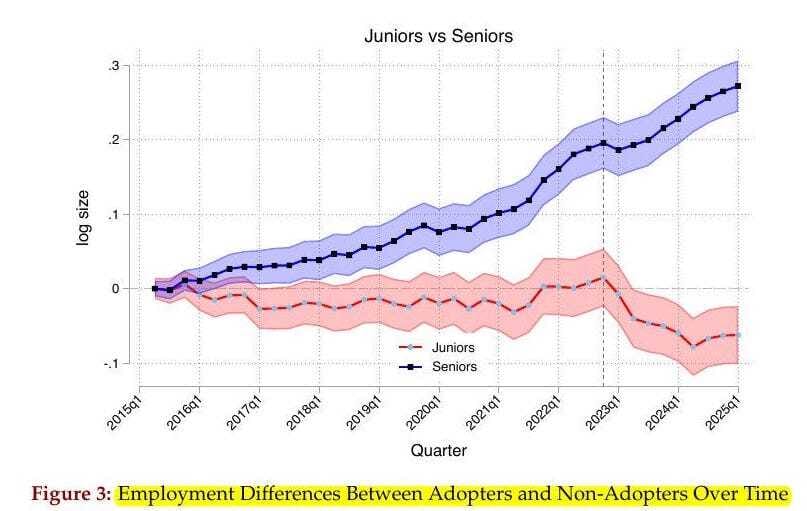
Why This Matters
Every leap in technology forces us to ask the same question: Who is this really for?
AI is no exception. We celebrate its productivity, its speed, its magic. But the truth is, it’s not arriving in a vacuum. It’s landing in a world of high interest rates, tighter budgets, and rising costs of living.
So the question isn’t just: What can AI do?
It’s: Who will bear the cost — and who will take the gains?
Side A — Who Bears the Brunt (Workers, Middle Layers, Entry Roles)
Washington Post Editorial Board — AI adoption could shift bargaining power away from workers, with productivity gains not necessarily translating into higher wages. source
Stanford Digital Economy Lab (Brynjolfsson et al.) — Early deployments displace task bundles in entry roles; without upskilling, the transition risk falls on new graduates and junior staff. source
ArXiv Policy Model Study — AI adoption in entry-level roles could severely compress career ladders and slow wage progression. source
MarketWatch Report — On Wall Street, AI is replacing analysts and junior jobs first as firms train models on internal research. source
Reuters (New York Fed Survey) — While layoffs from AI adoption remain limited, managers expect reduced hiring plans in functions most exposed to automation. source
TechRadar Analysis — AI adoption rates are highest among professional services; managers leveraging copilots report faster cycle times and better output quality. source
HR Dive — As firms flatten hierarchies with AI, middle managers who re-skill into orchestration and product roles can see upward mobility. source
Axios Report — Corporate reorganizations driven by AI shift headcount to higher-value, revenue-adjacent teams; net effect depends on training budgets. source
Company Disclosures (Earnings Recaps) — Firms that quantify AI’s impact show measurable unit-economics gains (lower cost per task, faster cycle time) feeding margins.
Policy Brief Roundups — Consumers may benefit through lower prices and faster service where competition forces pass-through of productivity gains.

The Numbers in Plain English
AI Productivity Gains — Who Feels Them Most
Employment among software developers aged 22–25 declined by 20% from AI automation.
36% of workers aged 18–34 use AI at work, compared to just 18% of workers aged 55–74.
Gen Z is often coaching senior managers on AI tools, raising productivity, but entry-level roles are shrinking as tasks get automated.
Young workers under 30 face reduced employment, shorter work hours, and higher unemployment risk; senior managers remain largely insulated.
Hawkish Macro Policies — Who Pays the Price
Wages of young workers fall faster after rate hikes, while senior workers’ pay is more stable.
Young employees in manufacturing and services see sharper cuts in hours and jobs when interest rates rise; managers’ compensation barely shifts.
Economic downturns hit new entrants hardest — longer job searches, fewer openings, more instability.
Older workers adjust by trimming hours, while younger workers face sudden layoffs.
The Bigger Fear — How This Feels at Home
The story is bigger than AI or rates. It’s about age, opportunity, and security.
For younger workers, AI can feel like a closed door: jobs disappearing, experience requirements rising, and wages falling faster with every policy tightening.
For senior managers, the story is different. Their roles are strategic, harder to automate, and more stable in downturns. They don’t face layoffs — they make the decisions.
So we are left with this paradox: the economy grows, productivity rises, but for the people who should be building their futures, the ladder itself feels like it’s being pulled away.
What You Can Do Now
If you’re working: Don’t just learn AI, teach it. The ones who thrive will be those who can show their managers how to use it better.
If you’re leading: Remember — efficiency without humanity erodes trust. Use AI to elevate, not eliminate.
If you’re investing: Watch who the winners are — the companies that prove AI’s value while retaining trust and stability in their workforce.
Thought to fight
The pie is getting bigger. But growth is not the point.
The real question is: Who gets the bigger slice — the young workers building their future, or the senior leaders protecting their present?
